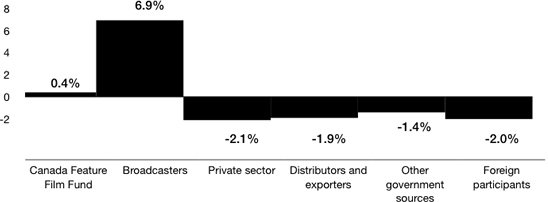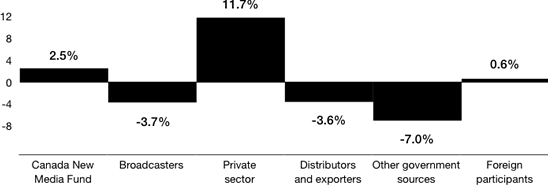| Strategic objectives | Key performance indicators | Targets |
2009-2010
results |
|---|---|---|---|
| Invest in audiovisual industry to attract other forms of financing | Percentage of financing from other sources of funding | Maintain or increase percentage of financing from other sources while decreasing Telefilm’s financial participation | Share of overall budgets held steady for feature film (about equal to the previous year), and the CNMF saw a slight increase (2.5% over the previous year) in its share of financing. There was a marked increase in financing by broadcasters for feature film and a jump in private investment in new media. |
| Companies increase their capacity through sales and business development at markets | Level of sales and business at markets | Maintain or increase Canadian and international sales and business development | Sales at international markets are up for the third year in a row—a 26% increase for sales and pre-sales combined. For every dollar Telefilm invested, Canadian companies produced $16 in sales at international markets (compared to $11 in 2008) 4 . |
| Industry professionals benefit from high-quality training initiatives | Level of satisfaction and positive career impact due to Telefilm training and development programs and initiatives | Maintain or increase satisfaction levels with training initiatives format and outcomes | Satisfaction scores maintained within the average range of 4 to 4.2 out of 5. |
| Visible minorities, official languages, minority professionals and Aboriginal professionals benefit from opportunities to advance in their careers | Level of resources committed to programs and initiatives designed to promote professional development within culturally diverse communities | Maintain or increase the level of investments | Levels of Telefilm’s support were generally maintained in 2009-2010. |
Because Telefilm is often the first investor in a project, its contribution not only gets Canadian productions off the ground but also helps attract other investors. Typically, Telefilm’s involvement leads to strong financial participation from other parties.
Canada Feature Film Fund
In 2009-2010, Telefilm supported 43 feature film productions through the Canada Feature Film Fund (CFFF)—two more projects than the previous year. Total budgets increased by 3%. In 2008-2009, there was relative balance between French-language and English-language projects, both in numbers supported and in budget levels, but this year the balance tipped noticeably toward English-language projects.
Financial analysis: 2009-2010 – CFFF
Production – new contracts only
|
Number of
productions |
Total
budgets (in thousands of $) |
Budgets
(in thousands of $)* |
CFFF | Broadcasters |
Private
sector |
Distributors
and exporters |
Other
government sources |
Foreign
participants |
|
|---|---|---|---|---|---|---|---|---|---|
| French-language projects | 16 | 76,170 | 67,093 | 32.4 % | 1.4 % | 6.1 % | 8.7 % | 48.5 % | 2.9 % |
| English-language projects | 27 | 116,229 | 111,966 | 40.2 % | 12.0 % | 8.7 % | 7.9 % | 25.7 % | 5.5 % |
| Total | 43 | 192,399 | 179,059 | 37.3 % | 8.0 % | 7.7 % | 8.2 % | 34.3 % | 4.5 % |
* Does not include the foreign share
($13.3M) of official coproduction budgets in which Canada is a minority
or equal share partner.
Source: Telefilm database
The percentage contribution of the CFFF to all production budgets has held steady relative to last year, edging upward only slightly from 36.9% to 37.3%. Considering the challenging economic climate, this “one-third start” represents a strong base for leveraging other financing. Financing from the private sector, distributors/exporters, other government sources and foreign participants are all down, but not significantly. Moreover, there was a larger injection of financing from broadcasters compared to last year.
Production – feature film – English and French combined – difference in budget share – 2008-2009 to 2009-2010

Source: Telefilm database
Canada New Media Fund
This past year, Telefilm invested in 26 interactive media projects through the Canada New Media Fund (CNMF). Eighteen of these were English-language projects, and eight were French-language projects. This is an absolute reversal from the previous year, in which Telefilm funded more French-language than English-language projects.
2009-2010 CNMF – supported projects and credit roll
Arguably, the hallmark of Telefilm’s administration of the CNMF over the past decade was its propensity to make cutting-edge decisions—to anticipate the importance of emerging technologies and to work with independent content developers on truly new and exciting projects. Last year, Critter Crunch, by Capybara Games, won two awards for its 2008 mobile version. In 2009, the CNMF funded a PlayStation Network (PSN) version of the game and it was awarded Best Downloadable Game at the Canadian Video Games Competition as well as Best PS3 Puzzle game in 2010.
2009-2010 CNMF – supported projects by platform

Source: Telefilm database
Financial analysis: 2009-2010 – CNMF
Production – new contracts only
|
Number of
productions |
Total budgets
(in thousands of $) |
CNMF | Broadcasters |
Private
sector |
Distributors
and exporters |
Other
government sources |
Foreign
participation |
|
|---|---|---|---|---|---|---|---|---|
| French-language projects | 8 | 3,871 | 57.5 % | 1.2 % | 38.8 % | 1.3 % | 1.2 % | 0.0 % |
| English-language projects | 18 | 6,350 | 47.6 % | 1.1 % | 42.5 % | 0.4 % | 7.4 % | 1.0 % |
| Total | 26 | 10,221 | 51.4 % | 1.1 % | 41.1 % | 0.7 % | 5.1 % | 0.6 % |
Source: Telefilm database
Interactive media is much more fragile and segmented than the feature film industry. As a result, Telefilm’s percentage of financial contribution to this industry tends to be higher than for feature film. The CNMF has held steady at an average of half of all budget financing for the past two years. This year, it has gone up slightly, to 51.4% compared to last year’s 48.9%.
Canadian new media misses foreign investment dollars
As recently as 2007-2008, foreign money accounted for a third of all interactive media financing in Canada. However, foreign investment appears to have all but dried up in the past two years. As has been the case with other segments of the industry, the global economic crisis has no doubt played a role in these shifting levels of investment financing.
Production – interactive media – English and French combined – difference in budget share – 2008-2009 to 2009-2010

Source: Telefilm database
Telefilm’s strategy to build foreign revenues and investment for the Canadian film, television and interactive media industry has shown considerable success despite a worldwide recession.
Surveys of the sales activities of Telefilm-supported Canadian participants at key international markets for film and television productions in 2009 5 demonstrate that for every dollar Telefilm invested in these markets, Canadian companies reported more than $16 in sales.
If the analysis expands to include all likely sales that are expected to result from discussions originating from these markets, the figure rises to $100 in sales, presales and working sales for every dollar invested.
Dollars worth of sales for every dollar spent by Telefilm
| Berlin | Hong Kong | MIPTV | Cannes | MIPCOM | Total | |
|---|---|---|---|---|---|---|
| Completed sales and presales | $7 | $0 | $1 | $40 | $13 | $16 |
| All sales activity including likely deals | $126 | $3 | $34 | $173 | $76 | $100 |
Source: Strategic Inc.
International activities – film and television markets
As reported by many of Telefilm’s responding clients, the economic climate of the past year had a negative influence on sales in several markets. Notably, Hong Kong and MIPTV saw considerable declines in closed sales between 2008 and 2009—from $2M to nil in Hong Kong, and from $5M to $0.3M at MIPTV. However, strong sales performances at Cannes and MIPCOM were sufficient to raise the overall sales by 19% relative to the previous year.
However, in 2009, international buyers were more willing to pre-purchase Canadian titles, and this resulted in a significant jump in presales figures. In fact, when completed presale deals are combined with completed sales, overall sales volume has increased 26% year-over-year. In dollar figures, that’s close to $18M. If working deals are included, this total climbs to about $108M—a 27% increase over 2008.
Coproduction and co-venture activity in 2009 reached a total of 71 deals, involving 17 countries and valued at more than $134M. This is down from the previous year’s total of $233M. Hong Kong saw the largest drop in coproduction volume (down by almost $40M) while MIPTV was the only market that logged an increase (up from $13.4M in 2008).
International activities – interactive digital media
In 2009, two interactive media markets were tracked: Game Connection San Francisco and Game Connection Europe (held in Lyon, France). Sales were slow at both Game Connection events. This indicates that interactive media has taken a harder hit than the traditional media of film and television.
Overall, only one deal worth $50,000 was reported from the 30 respondents at the two markets. Likely sales were more promising with a combined total of almost $26M, with an average per company of about $1.9M. Despite a slow year for closed deals, the overall client experience at the Game Connection events was positive. A little over 76% of clients at Game Connection San Francisco and about 88% at Game Connection Europe stated they were very or somewhat satisfied with the event.
As one of Telefilm’s main corporate objectives, training and business development represents a “bottom-up” approach to building the capacity of the Canadian audiovisual industry. Recognizing the importance of human capital, Telefilm has supported several diverse training initiatives over the last few years, including official language project development, script writing, digital technologies, and festival-oriented development.
Business development and training highlights
Telefilm Canada Features Comedy Lab
Telefilm Canada Features Comedy Lab is Canada’s first advanced professional program designed to develop and package feature-length comedy films. It pairs experienced Canadian feature film producers, their writer and/or director teams and their comedy scripts with the best comedy minds in the world. The objective is to develop—and package for investment—five viable English-language feature-length comedies for 2010. The program is sponsored by Telefilm and presented by the Canadian Film Centre in collaboration with Just for Laughs.
The stars come out
Canada is internationally famous for its comedy and comedians, and the stars were definitely out to support the Telefilm Canada Features Comedy Lab. The program was chaired by award-winning comedy veteran Eugene Levy, and included such mentors and guests as comedy producers Ivan Reitman, Alan Blomquist, Jimmy Miller, and Tai Duncan.
A selection committee of international comedy industry professionals chose the following five projects and teams to enter the Lab:
- Workplace comedy Servitude: writer/producer Michael Sparaga, director Warren P. Sonoda.
- Romantic comedy That Burning Feeling: writer Nicolas Citton, producer/director Jason James.
- Shtick comedy Ramington’s: Men of Steel: writer Sacha Pavlovic, producer Mark Montefiore.
- Cowgirl comedy Saddlebags: writer Christine Lippa, producers Elizabeth Yake, Angela Heck.
- Female comedy Two of Me: writer/director Mina Shum, producer Stephen Hegyes.
Multiplatform, Multi-Success
The objective of these workshops is to enhance the industry’s skills and maximize the potential to reach audiences. This initiative specifically targets the creation and exploitation of content in a multiplatform environment. In particular, it focuses on opportunities offered by social media, online video distribution, and mobile platforms.
Measuring the impact
Telefilm conducted a survey among 95 participants in the Multiplatform, Multi-Success workshops in 2009, and the feedback was positive. Two separate workshops were surveyed. The first group rated their overall satisfaction with the program at 4.23 out of a possible five and the second group gave an average score of 4.16 out of a possible five—well within the range of levels that have been reported over the last few years.
“I am impressed by Telefilm Canada’s outreach programs to producers and industry people. I intend to make further use of its resources in the future. I am quite impressed with the professionalism shown by the Telefilm personnel, as well as the chosen presenters.” – Quote from a participant
Featuring Aboriginal Stories Program
The Featuring Aboriginal Stories Program targets Aboriginal feature-film projects at different stages of development. At each stage, participants benefit from a combination of training, professional development and personalized mentorship activities, and also receive a development advance. The Program aims to broaden the industry’s capacity within Aboriginal communities and to facilitate access to the main funding programs of the Canada Feature Film Fund for Aboriginal filmmakers.
Program well received
Participants of this program were surveyed in 2009. Out of 13 participants who responded to the survey, 10 of them rated the program at four or higher out of five. The mean rating for all participants was four out of a possible five.
“These programs are profoundly vital to the inclusion of Aboriginal stories in Canada and to the development of a body of Aboriginal artists who are in it for the long run.” – Quote from a participant
Producers package at Show Canada
Show Canada, organized annually by MPTAC, is a key gathering of Canada’s film industry. In 2009, Telefilm sponsored the attendance of 15 producers for two days of the event, including screenings, panel discussions and networking. Included in this initiative was an exclusive producer’s panel event that brought together the selected producers along with distributors and Telefilm industry specialists. The forum was well received, and the producers were very enthusiastic about the event.
A unique experience
“The financial, informational and panel assistance provided by Telefilm were invaluable and I am extremely grateful that I was able to benefit from them. My project has benefited directly from conversations I was able to have with Cineplex and distributors.” – Quote from a participant
In 2009-2010, as in 2008-2009, Telefilm committed a total of $7.5M in funding to multicultural, Aboriginal and official language minority projects.
Featuring Aboriginal Stories Program
- 2009-2010 was the second year of the program that seeks to broaden the industry’s capacity within Aboriginal communities, and give Aboriginal filmmakers easier access to the main funding programs of the CFFF.
- Telefilm committed about $0.4M in development funding to 22 Aboriginal projects across Canada, doubling the $0.2M and 11 projects committed in 2008.
Official language minority communities
- 2009-2010 was the third year Telefilm offered tailored programs ( Écrire au Long, Feature It!, Production component, Multi-platform, Multi-Success) that seek to broaden the industry’s capacity within official language minority communities, and give their filmmakers easier access to the main funding programs of the CFFF.
- Telefilm’s support of French-language projects and events outside of Quebec represented 2% of French-language commitments, an increase of 1.4% since the previous year. Commitments to English-language projects and initiatives within Quebec represented 17.4% of English-language commitments, a decrease of 11% from last year when English-language commitments were unusually high due to three national productions financed in Quebec.
- In 2009-2010, Telefilm conducted comprehensive evaluations of the Official Languages Activities and Versioning Assistance Programs. In consultation with members of the industry, Telefilm will review the results of these findings in 2010-2011 to determine how to improve the effectiveness and efficiency of these programs.
A portfolio of worthwhile projects
- The 10 th edition of the imagineNATIVE Film and Media Arts Festival presented 168 audiovisual works developed and produced by Canadian and international indigenous creators.
- Isuma.tv, a portal dedicated to Canadian and global indigenous filmmakers, is Canada’s first channel that uses the Internet to distribute indigenous feature films, documentaries and other independent Canadian films to remote, underserved Inuit and Aboriginal communities.
- Inside Hana’s Suitcase, directed by Canadian filmmaker Larry Weinstein, is a documentary about a lost child of the Holocaust based on the best-selling novel of the same name. It received a Canwest Award for Best Documentary at the Victoria Film Festival.
- Off World is a film that follows a young Toronto man on a life-changing journey to his birthplace, a slum in the Philippines. By Mateo Guez, it opened at the Reel World Film Festival and was screened at Telefilm’s Perspective Canada initiative in Cannes.
- Cairo Time is a Canada-Ireland coproduction drama about cross-cultural romance. Written and directed by Ruba Nada, and starring Patricia Clarkson and Alexander Siddig, the film won Best Canadian Feature Film at TIFF 2009. It was acquired for U.S. distribution, and included in TIFF’s Canada’s Top 10 2009.
- Prom Night in Mississippi is a documentary that follows high school seniors preparing for the first racially integrated prom in Charleston, Mississippi. Directed by Canadian Paul Saltzman, the project received award nominations from the Director’s Guild of Canada and at Sundance.
- Before Tomorrow is the story of a woman and her grandson as they fight to survive in remote northern Canada. Directed by Marie-Hélène Cousineau and Madeline Ivalu, the film was adapted for the screen from the novel For morgendagen by Danish writer Jørn Riel. It was selected for competition at Sundance.
- Kissed by Lightning follows Mavis Dogblood, a Mohawk painter dealing with the loss of her husband. This feature film directorial debut of Shelley Niro was screened at many North American film festivals. Lead actress Kateri Walker was nominated for an ACTRA Award.
- Nurse.Fighter.Boy is an urban love story set to the rhythms of reggae. This feature film debut of Charles Officer won a Genie Award for Best Achievement in Music – Original Song, and also won the audience award at the Mannheim-Heidelberg Festival. It has been acquired for U.S. distribution.
- Cooking with Stella follows the exploits of a scheming personal chef to the Canadian High Commission in New Delhi as she adapts to unconventional new Canadian diplomats. This quirky comedy is the first feature film by director/writer Dilip Mehta, and premiered at TIFF 2009.


